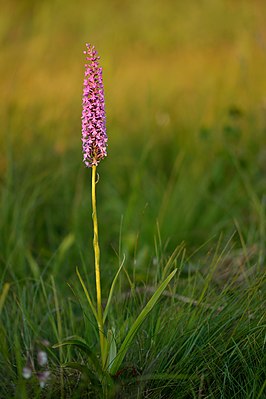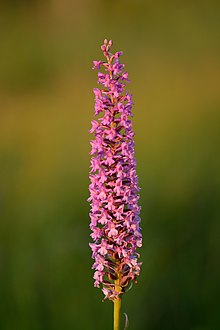Dense-flowered Händelwurz
| Dense-flowered Händelwurz | ||||||||||||
|---|---|---|---|---|---|---|---|---|---|---|---|---|

Dense-flowered Händelwurz ( Gymnadenia densiflora ) |
||||||||||||
| Systematics | ||||||||||||
|
||||||||||||
| Scientific name | ||||||||||||
| Gymnadenia densiflora | ||||||||||||
| ( Wahlenb. ) A. Dietr. |
The dense-flowered Händelwurz (also dense-flowered large Händelwurz, dense-flowered Mücken-Händelwurz), scientific name Gymnadenia densiflora , is a taxonomically controversial plant species from the orchid family with distribution in Europe. Many botanists regard it as an independent species, while others see the plant clan as a subspecies or variety of the very similar mosquito-handelwort ( Gymnadenia conopsea ).
features
The dense-flowered Handelwurz is a perennial herbaceous plant and reaches stature heights of (40 -) 54–82 (- 100) centimeters. The tubers of this tuber geophytes are thick as with all related clans, flattened, bifida, shared with hand-shaped, short lobes. The shoot is stiff and upright, round in cross-section, sometimes with two longitudinal keels upwards. The leaves sit in two rows, heaped in the lower third, above which often two rudimentary leaves with leaf sheaths . They are linear, dark green and keeled on the underside. The lowest leaves have a leaf sheath, the upper ones closer to the inflorescence are mostly sheathless. The lower leaves reach about 20 (16 to 25, rarely a little below or above) millimeters in width and are therefore noticeably wider than those of Gymnadenia conopsea s. st .
The inflorescence is cylindrical in outline, it is rich and densely flowered, about (5 -) 6–15 (- 24) centimeters long, with about 42 to well over a hundred individual flowers. The flowers are pink to light purple in color, they have a pleasant scent of clover or lilac, their scent is noticeably more pronounced than that of Gymnadenia conopsea s. str., both are biochemically distinguishable, although pollinators do not differentiate them according to current knowledge. The lip is clearly three-lobed and noticeably wider than it is long, the side lobes larger than the central one. The outer bracts of the perianth are more or less horizontal. The spur is slender, long and curved, it reaches about 8 to 12 millimeters in length.
The species is morphologically less variable than the multifaceted Gymnadenia conopsea and, depending on the taxonomic view, cannot always be reliably differentiated from it, since the characteristics partially overlap, so that the clan delimited by genetic markers is not always congruent with the morphologically differentiated ones. In an examination of numerous European individuals, including German individuals, only 77 percent of the morphologically addressed Gymnadenia densiflora matched the genetically defined taxon. A reliable determination according to morphological characteristics is currently only possible to a limited extent, at least in Central Europe.
The species blooms noticeably later than the typical Gymnadenia conopsea (of which, however, late-blooming clans have also been described, the allocation of which is controversial), both in England and in southern Central Europe from around the end of June to mid-August. Hybrids between the two are rarely given, for example from a mixed population in Hampshire (England).
Gymnadenia densiflora is diploid, chromosome number 2n = 40. In contrast to other small species from the collective species Gymnadenia conopsea s. l. tetraploid plants do not occur.
distribution
The species occurs in almost all of Europe, from Northern Norway (Scandinavia) in the north to Italy in the south, it becomes more common towards the southeast. In Great Britain it is common in England and Wales, and extremely rare in Scotland. In Ireland it is the most common type of Gymnadenia . In Austria the species is scattered to rare, its distribution in Germany is unclear.
Location
The species grows preferentially in lime-rich swamp areas, spring moors, wet meadows and dune valleys, it also occurs occasionally on peat or in lime-poor, soil-wet locations. She prefers fully sunny locations. In contrast to Gymnadenia conopsea s. st. it occurs only in exceptional cases on dry locations such as limestone grasslands . In Austria, the dense-flowered Händelwurz is indicated as rare in springy locations in the submontane to montane altitude range.
Phylogeny, taxonomy, systematics
The species was first described by Göran Wahlenberg in 1806 as Orchis densiflora , but since 1835 it has long been considered a variety of Gymnadenia conopsea ( Gymnadenia conopsea (L.) R.Br. var. Densiflora (Wahlenberg) Lindley). Already in 1839 Albert Gottfried Dietrich combined them, in species rank, as Gymnadenia densiflora . Numerous botanists do not regard them as a separate species, but as a subspecies of a broad collective species Gymnadenia conopsea , then Gymnadenia conopsea (L.) R.Br. subsp. densiflora (Wahlenb.) called K. Richter. For a long time botanists had noticed that a number of local clans, also morphologically distinguishable, exist within the Mosquito-Haendelwurz, but there was no agreement on their demarcation and status. For about 20 years, genetic analyzes have shown that Gymnadenia densiflora and Gymnadenia conopsea are probably not sister species , and that both clans are genetically just as different as, for example, the fragrant Handelwort ( Gymnadenia odoratissima ) , which has long been morphologically different (results summarized in Bateman and colleagues 2018). Since then, the prevailing opinion is that they are separate species. Since the sister group relationship and the demarcation of the two clans are still controversial, there is no consensus on the classification, at least one expert (Pierre Delforge) still regards it as a variety, some others as a subspecies.
The status of a clan of calcareous dune valleys on the North Sea coast known as Gymnadenia densiflora (Wahlenb.) A.Dietr is also unclear . var. friesica (Schltr.) L. Lewis is called.
Individual evidence
- ↑ a b Karol Marhold, Ivana Jongepierová, Anna Krahulcová, Jaromír Kučera (2005): Morphological and karyological differentiation of Gymnadenia densiflora and G. conopsea in the Czech Republic and Slovakia. Preslia 77: 159-176.
- ^ Anne Harrap, Simon Harrap: Orchids of Britain and Ireland: A Field and Site Guide. A&C Black, London 2005. ISBN 978-1-4081-0571-9 . Marsh Fragrant Orchid, pp. 267-271.
- ↑ a b c d Tine Meekers, Michael J. Hutchings, Olivier Honnay, Hans Jacquemyn (2012): Biological Flora of the British Isles: Gymnadenia conopsea s. l. Journal of Ecology 100: 1269-1288. doi: 10.1111 / j.1365-2745.2012.02006.x
- ↑ a b Richard M. Bateman, Alexander RM Murphy, Peter M. Hollingsworth, Michelle L. Hart, Ian Denholm, Paula J. Rudall (2018): Molecular and morphological phylogenetics of the digitate-tubered clade within subtribe Orchidinae s. s. (Orchidaceae: Orchideae). Kew Bulletin 73: 54 (30 Pages) doi: 10.1007 / S12225-018-9782-1
- ↑ Christiane Stark, Stefan G. Michalski, Wiesław Babik, Grit Winterfeld, Walter Durka (2011): Strong genetic differentiation between Gymnadenia conopsea and G. densiflora despite morphological similarity. Plant Systematics and Evolution 293: 213-226. doi: 10.1007 / s00606-011-0439-x
- ↑ Jarle W. Bjerke and Karl-Birger Strann (2009): Orkideen tettbrudespore Gymnadenia densiflora i North-Norge. Blyttia 67 (9): 126-133.
- ^ A b Walter Vöth: Distribution maps of Gymnadenia, Nigritella, x Gymnigritella, x Pseudadenia and x Pseuditella species (Orchidaceae) to be found in Austria. In: Linz Biological Contributions. 36th year, issue 1, Linz 2004, p. 493-519 ( PDF on ZOBODAT ).
- ↑ Leslie Lewis (2015): Reclassification of Gymnadenia conopsea var. Friesica as a variety of Gymnadenia densiflora. Journal of European Orchids 47 (2-4): 293-302.
Web links
- Gymnadenia densiflora (Wahlenb.) A. Dietr., Dense-flowered Händelwurz at FloraWeb (with distribution map for Germany).
- Subspecies and variations of Gymnadenia conopsea at Flora-de: Flora von Deutschland, by Thomas Meyer (old name of the website: Flowers in Swabia).
- Dense-flowered Mosquito-Haendelwurz AHO working group local orchids NRW.
- Gymnadenia densiflora . John and Gerry's Orchids of Britain and Europe.


